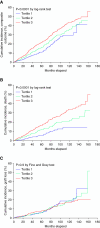Extracellular Fluid Volume and Mortality after Kidney Transplantation
- PMID: 39382974
- PMCID: PMC11687982
- DOI: 10.34067/KID.0000000587
Extracellular Fluid Volume and Mortality after Kidney Transplantation
Abstract
Key Points:
Post-transplantation extracellular fluid volume (ECV) is not only influenced by recipient characteristics and allograft function, but also by transplantation-specific factors.
In multivariable cause-specific Cox analyses, increased ECV 3 months after kidney transplantation is independently associated with all-cause mortality but not graft loss.
Multivariable linear regression further identified increased 3-month ECV as an independent predictor of reduced GFR measurement at 12 months.
Background: High extracellular fluid volume (ECV) is associated with an increased risk of death in nontransplanted patients with CKD. By contrast, both the determinants and the prognosis value of ECV in kidney transplant recipients remain unclear.
Methods: We studied a bicentric prospective cohort of 2057 kidney transplant recipients who underwent GFR measurement (mGFR) 3 months after transplantation. We calculated ECV from iohexol plasma disappearance curve and analyzed its association with patient's characteristics and outcomes.
Results: The mean ECV and mGFR were 14.6±2.6 L/1.73 m2 and 52±16 ml/min per 1.73 m2, respectively. Multiple linear regression identified male sex, older donor and recipient ages, deceased donor, nonpreemptive transplantation, diabetes, cardiac arrhythmia, heart failure, proteinuria, and higher mGFR as independent factors associated with increased ECV. In multivariable cause-specific Cox analyzes, higher tertiles of ECV were associated with increased mortality (tertile 1 as reference; hazard ratio [95% confidence interval] for tertile 2: 1.65 [1.11 to 2.47]; tertile 3: 1.80 [1.18 to 2.74]) but not graft loss. Increased ECV, 3 months after transplantation, was a predictor of reduced mGFR at 12 months after adjusting for 3-month mGFR and other confounding factors (β coefficient: −0.06; 95% confidence interval [−0.09 to −0.02]).
Conclusions: An elevated ECV 3 months after kidney transplantation is independently associated with increased mortality and decreased mGFR at 12 months, but not with graft loss.
Conflict of interest statement
Disclosure forms, as provided by each author, are available with the online version of the article at
Figures





References
LinkOut - more resources
Full Text Sources

